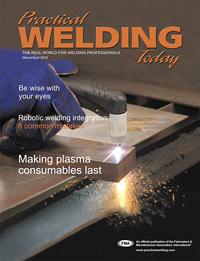Senior Sales Application Engineer
- FMA
- The Fabricator
- FABTECH
- Canadian Metalworking
Categories
- Additive Manufacturing
- Aluminum Welding
- Arc Welding
- Assembly and Joining
- Automation and Robotics
- Bending and Forming
- Consumables
- Cutting and Weld Prep
- Electric Vehicles
- En Español
- Finishing
- Hydroforming
- Laser Cutting
- Laser Welding
- Machining
- Manufacturing Software
- Materials Handling
- Metals/Materials
- Oxyfuel Cutting
- Plasma Cutting
- Power Tools
- Punching and Other Holemaking
- Roll Forming
- Safety
- Sawing
- Shearing
- Shop Management
- Testing and Measuring
- Tube and Pipe Fabrication
- Tube and Pipe Production
- Waterjet Cutting
Industry Directory
Webcasts
Podcasts
FAB 40
Advertise
Subscribe
Account Login
Search
Consumables Corner: Examining weld cracking, Part I—Hot cracking
- By Jay Ginder and Jerry Mathison
- July 15, 2014
- Article
- Consumables
Editor’s Note: This is the first article of a two-part series.
Q: I work in a midsized job shop, and we weld with the FCAW, GMAW, and SMAW processes. Occasionally we encounter weld cracking issues. What causes weld cracking, and what can I do to prevent it?
A: To ensure that the measures you take to correct weld cracking are successful, you must first thoroughly investigate why cracking is occurring in the first place. It is critical to understand what causes weld cracks if you’re going to prevent them in the future.
First, take into consideration the material type and thickness, as well as the level of residual stress in the weldment, before fabricating begins. This will help you to avoid having to repair cracks after the welding is completed. With that said, three main types of weld cracks exist: hot cracks, stress cracks, and hydrogen cracks.
Hot cracks generally occur before the weld bead is completed and are longitudinal. They are also referred to as centerline cracks because they usually appear at the weld centerline. Hot cracks most commonly occur at high travel speeds, but they are known to happen at normal travel speeds as well. When elements or compounds with a lower melting point, such as sulfur, phosphorus, copper, boron, and selenium, end up at the weld centerline during solidification, the end result is typically a hot crack.
To eliminate hot cracks you may want to consider decreasing your travel speed. By doing so you will be able to lay a weld puddle that is rounder in shape. Research verifies that a “teardrop” weld puddle may be more susceptible to hot cracking than one that is rounded.
You also should look at using filler metal with higher manganese content, or one that has a more basic slag system. For instance, if you’re experiencing hot cracks with an E7014 electrode, you could change to an E7018.
Last, consider removing the source of the low-melting-point compound. This may be difficult if the compound is part of the makeup of the material being used, but it is still an option.
We sill discuss stress and hydrogen cracks in Part II.
About the Authors
Jay Ginder
Filler Metal Manufacturing Center 801 Wilson Ave.
Hanover, PA 17331
Jerry Mathison
Senior Sales Application Engineer
411 S. Ebenezer Road
Florence, SC 29501
843-669-4411
About the Publication
Related Companies
subscribe now

The Welder, formerly known as Practical Welding Today, is a showcase of the real people who make the products we use and work with every day. This magazine has served the welding community in North America well for more than 20 years.
start your free subscription- Stay connected from anywhere

Easily access valuable industry resources now with full access to the digital edition of The Fabricator.

Easily access valuable industry resources now with full access to the digital edition of The Welder.

Easily access valuable industry resources now with full access to the digital edition of The Tube and Pipe Journal.
- Podcasting
- Podcast:
- The Fabricator Podcast
- Published:
- 04/16/2024
- Running Time:
- 63:29
In this episode of The Fabricator Podcast, Caleb Chamberlain, co-founder and CEO of OSH Cut, discusses his company’s...
- Trending Articles
Sheffield Forgemasters makes global leap in welding technology

Welding student from Utah to represent the U.S. at WorldSkills 2024

Lincoln Electric announces executive appointments

Lincoln Electric acquires RedViking

Engine-driven welding machines include integrated air compressors

- Industry Events
16th Annual Safety Conference
- April 30 - May 1, 2024
- Elgin,
Pipe and Tube Conference
- May 21 - 22, 2024
- Omaha, NE
World-Class Roll Forming Workshop
- June 5 - 6, 2024
- Louisville, KY
Advanced Laser Application Workshop
- June 25 - 27, 2024
- Novi, MI



























